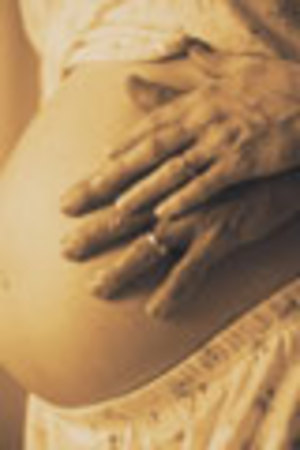In the United States, approximately 300-500 women die every year from giving birth, 11% of infants are born too early, 7.4% have low birth weight, and 7 of every 1000 live births die within the first year of life. These are stunning statistics; however, there are many things an expectant mother can do to reduce these statistics. (Grosvenor & Smolin, 2006)
Expectant Mother’s Weight
During the 40 weeks the mother carries the fetus, the fetus receives all the nutrients and nourishment from the mother via the placenta; so in essence, the mother is eating for two: she is eating for her own nutritional health, and the health of the child she carries. During pregnancy, a woman’s body undergoes significant changes that cause weight gain: blood volume increases 50%, vital organs (heart, kidneys, and lungs) must work harder to eliminate waste and deliver oxygen and nutrients, body fat increases to sustain energy during later pregnancy, the uterus grows, and muscles and ligaments relax to allow growth of the fetus; all these changes require different nutrients. (Grosvenor & Smolin, 2006)
The weight a woman gains during pregnancy is vitally important, too much or too little can negatively alter the mother and child’s health; too little weight gain raises the risk of a low-birth-weight, and gaining too much weight raises the risk of gestational diabetes, high blood pressure, difficult delivery, cesarean section, and a larger-for-gestational-age baby. A healthy woman of normal weight are recommended to gain 25 to 35 pounds; an underweight woman is recommended to gain up to 40 pounds; and an overweight woman is recommended to gain only 15 to 25 pounds during pregnancy. This 25 to 35 pound weight gain is not all body fat; it amounts to roughly a seven to eight pound fetus, two pounds of amniotic fluid, one to two pound placenta, two pound increase in uterine weight, three to four pounds increase in blood volume, two pounds increase of breast tissue, four pounds of extracellular fluids, and four to eleven pounds of body fat. Most of this weight gains is lost during the first year following pregnancy. (Grosvenor & Smolin, 2006)
Dieting
Dieting is not recommended during pregnancy (not even for obese mothers), and regular exercise may usually be continued through pregnancy with the obstetrician’s approval, since exercise during pregnancy reduces stress; improves fitness, mood, body image, digestion, back pain, constipation, and recovery time following birth; and reduces the risk of developing gestational diabetes.
Morning sickness may require frequent snacking on small amounts of foods such as crackers and bread. Heartburn and constipation are frequent complaints due to organ crowding and uterine muscle relaxation also affecting the gastrointestinal tract. Heartburn can be controlled through limiting chocolate, caffeine, high fat foods, or other known causes of heartburn, along with small meals spread throughout the day, and staying upright following eating; constipation can be addressed through adequate fluid intake and a diet high in fiber. (Grosvenor & Smolin, 2006)
Nutritional Needs
A pregnant woman’s nutrition needs do increase, but she is not consuming calories for two. The first trimester does not see a significant increase in calorie expenditure, but the second and third trimester energy and nutrition needs would be met by eating a second lunch or breakfast daily. During the second trimester, calories should be increased by an additional 340 calories per day; during the third trimester, calories should be increased by an additional 452 calories per day. Protein is responsible for new cell building, so pregnant woman need an additional 25 grams of protein daily during the second and third trimesters. According to the Food Guide Pyramid, pregnant women need one additional serving of milk, vegetables, meat, and bread, with no increase in fruit servings for a 25 year old woman. (Grosvenor & Smolin, 2006)
Water Needs
Due to the increase in blood volume, the creation of amniotic fluid, and prevention of constipation, which equals around six to nine liters of water, water needs increase from 2.7 liters to 3 liters a day (including the water received from food). Vitamin and mineral needs increase during pregnancy; needs are usually met through increases in dietary consumption and supplementation. Folate is responsible for cell formation of the placenta and increased intake is needed prior to conception, since cells divide rapidly within the first weeks of pregnancy (usually before the mother is even aware she is pregnant). A deficiency in folate can result in megaloblastic anemia for the mother and nural tube defect (such as spina bifida), premature birth, low-birth weight, and mental retardation for the infant. To prevent deficiencies in vitamins and minerals, prenatal supplements are typically prescribed, along with a sensible, healthy diet. (Grosvenor & Smolin, 2006)
Many pregnant women experience food cravings or aversions which are generally not harmful; however, some women crave nonfood items such as clay, dirt, laundry starch, ashes, baking soda, and many other substances, including toilet paper; this condition is referred to as pica (derived from the Latin word for magpie, a bird noted for eating anything). Pica can reduce nutrient absorption, reduce intake of nutritious foods, cause consumption of toxins, intestinal obstructions, iron-deficiency anemia, lead poisoning, and parasite infections. (Grosvenor & Smolin, 2006)
Smoking
Smoking and exposure to second hand smoke during pregnancy can affect the infant prior to birth and throughout life. Cigarette smoke constricts arteries, limits blood flow, reduces oxygen and nutrient delivery to fetus, and increases the risk of low birth weight, stillbirth, miscarriage, premature births, sudden infant death syndrome (a.k.a SIDS and crib death), respiratory problems, colds, and lung problems. (Grosvenor & Smolin, 2006)
Alcohol Consumption
Alcohol consumption is one of the major causes of preventable birth defects. Alcohol is classified as a teratogen (any chemical, physical, or biological agent that causes birth defects) that significantly damages the developing central nervous system of the fetus and also affects fetal growth, development, oxygen supply, and nutrition supply.
Exposure to alcohol causes a variety of disorders depending on the duration, time, and dose of alcohol, the most severe being fetal alcohol syndrome (FAS). FAS causes growth retardation, permanent brain damage, heart defects, urinary tract defects, impaired vision, impaired hearing, delayed language development, and facial deformities. Infants born with FAS have poor muscle tone and may be shaky, irritable, and experience alcohol withdrawal symptoms.
Alcohol consumption during pregnancy can also cause alcohol related neurodevelopmental disorders (ARND) characterized by mental and functioning impairments and alcohol related birth defects (ARBD) characterized by skeletal or major organ malformations. ARND and ARBD are less severe that FAS, but are three times more likely to occur. No level of alcohol consumption is safe during pregnancy; abnormalities are associated with alcohol consumption during each trimester. (Grosvenor & Smolin, 2006)
Substance Abuse
Substance abuse (use of cocaine, opiates, amphetamines, marijuana, and cocaine) during pregnancy affects up to 11% of babies born each year and if alcohol and nicotine were included, this number would be much higher. These substances cross the placenta and enter the blood of the fetus causing behavioral and learning problems during childhood, increases the risk of complications to the mother, significantly increases the number of miscarriages and spontaneous abortions, retards intrauterine growth, premature labor and delivery, low-birth-weight, abnormal arousal, abnormal attention, abnormal neurological functioning, and reduces oxygen and nutrients delivered to fetus. (Grosvenor & Smolin, 2006)
Gestational Diabetes
Gestational diabetes (diabetes during pregnancy that typically disappears after the baby is born) is more common in overweight and obese women, and it occurs in 2-6% of all pregnancies. Gestational diabetes puts the mother at a greater risk of developing Type 2 diabetes later in life. Diabetes increases the risk to the mother and the fetus. When the mother’s blood glucose levels are high, the fetus receives extra calories, usually resulting in infants who are large for gestational age and an increased health risk. Gestational diabetes is treated through a healthy diet, exercise (moderate), and insulin in some cases. (Grosvenor & Smolin, 2006)
Pregnancy Induced Hypertension
Pregnancy induced hypertension consist of several conditions that cause high blood pressure, occurs in 6-8% of pregnancies, and significantly increases the fetus and mother’s risk of illness and death (approximately 25% of pregnancy-related-maternal deaths are because of hypertension). Risk factors for developing pregnancy induced hypertension include mothers under the age of 20 or over the age of 35, low-income, and mothers with chronic hypertension or kidney disease.
Gestational hypertension is the mildest form and is characterized by a rise in blood pressure after the 20th week of pregnancy. If accompanied by protein in the urine and edema (excessive swelling of extremities), the condition is referred to as preeclampsia; preeclampsia is typically preceded by a gain of several pounds within only a couple days; it can progress to the more serious form of pregnancy induced hypertension referred to as eclampsia which causes life-threatening seizures. Treatment involves close medical monitoring and bed rest, but typically the condition resolves following delivery. What causes pregnancy induced hypertension remains a mystery. (Grosvenor & Smolin, 2006)
Teen Pregnancy
Teen pregnancies and pregnancies in women over the age of 35 carry additional risks to the fetus and the mother. Teen girls continue to grow for 4-7 years following the start of menstruation, because of this, pregnant teens generally have higher nutrition and nutrient needs. Teens are more apt to deliver low birth weight and preterm babies and are at a greater risk of developing pregnancy induced hypertension.
Older mothers tend to begin pregnancy with pre-existing conditions like cardiovascular disease, kidney problems, obesity, and diabetes and are at a higher risk of developing pregnancy induced hypertension, gestational diabetes, among other complications. These pre-existing conditions may require medications that alter nutrition, fertility, and the outcome of pregnancies. Older mothers also are at a higher risk of delivering low birth weight babies or babies with chromosomal abnormalities such as Down Syndrome. Because of these issues, the older mother and teen mother both require additional and closer medical monitoring. (Grosvenor & Smolin, 2006)
Nutritional Needs During Lactation
Nutrition needs for lactating women are higher than during pregnancy because the mother must produce milk that will meet the nutritional needs of her rapidly growing infant. During the first 6 months of breastfeeding the mother produces approximately 2.5-3.75 cups of milk a day; containing about 160 calories per cup, three cups of milk would uses an additional 500 calories from the mother, increasing the mother’s need for energy and protein. The mother is recommended to consume 330 calories a day over her pre-pregnancy need for the first six months of lactation, 400 calories a day following the first six months. (Grosvenor & Smolin, 2006)
According to the Food Guide Pyramid, lactating women need one additional serving of milk and vegetables, two additional servings of meat (an addition of approximately 25 grams of protein), and three additional servings from the bread group, with no increase in fruit servings for a 25 year old woman. During lactation, the mother needs approximately 1 liter (total 3.8 liters) of additional liquids daily to prevent dehydration. An increase in the consumption of vitamins and minerals during lactation is recommended, but can be achieved through a healthy diet. (Grosvenor & Smolin, 2006)
References
Grosvenor, M. B., & Smolin, L. A. (2006). Nutrition: Everyday choices. New Jersey: John Wiley & Sons, Inc.



